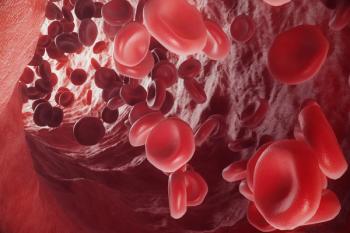
- ONCOLOGY Vol 14 No 3
- Volume 14
- Issue 3
Treatment of Patients With Mantle Cell and Aggressive B-Cell Non-Hodgkin’s Lymphoma Using the Monoclonal Anti-CD20 Antibody Rituximab: Evaluation of Safety and Response
While response rates of 50% have been reported after treatment of patients with low-grade follicular non-Hodgkin’s lymphoma (NHL) using the chimeric monoclonal anti-CD20 antibody rituximab (Rituxan), only minimal data are available on
While response rates of 50% have been reported after treatment of patients with low-grade follicular non-Hodgkin’s lymphoma (NHL) using the chimeric monoclonal anti-CD20 antibody rituximab (Rituxan), only minimal data are available on therapeutic results in patients with mantle cell lymphoma (MCL) or aggressive CD20-positive NHL. We report on 25 patients with intermediate- or high-grade NHL treated with 375 mg/m² of rituximab once weekly for 4 weeks.
Patients had either diffuse large B-cell lymphoma (DLBCL; N = 14), transformed follicular B-NHL (N = 7), or MCL (N = 4). Median age was 60 years (range, 36 to 81 years), and most patients (N = 17) had stage III/IV disease. At the time of treatment, 21 patients were in second or higher relapse, having received a median of two prior chemotherapeutic regimens. Three elderly patients (> 65 years old) were treated at first diagnosis.
Side effects were transient and of National Cancer Institute (NCI) grade 1/2 toxicity. Grade 3-4 adverse events occurred significantly less often than in patients with low-grade NHL (P < .01). So far, 23 patients are evaluable for response. There was 1 complete response (CR; duration, 3+ months) in 12 patients with primary DLBCL. Of seven patients with transformed follicular lymphoma, one achieved a CR (12+ months) and two patients had partial responses (PRs; 6 and 9 months). Two of four patients with MCL achieved a CR (8+ and 19+ months).
CONCLUSION: Although toxicity of rituximab was very low in patients with mantle cell NHL and aggressive B-NHL, efficacy was dependent on the lymphoma subtype. Remission rates up to 50% were observed in patients with transformed follicular NHL, as well as in patients with MCL. Further clinical studies are needed to investigate the activity of rituximab in aggressive lymphoma, either alone or in combination with chemotherapeutic regimens.
Articles in this issue
almost 26 years ago
FHIT Gene, Smoking, and Cervical Canceralmost 26 years ago
IOM Medical Error Estimates Questioned, But Legislation Consideredalmost 26 years ago
Less Toxic Therapies for Hodgkin’s Disease May Reduce Secondary CancersNewsletter
Stay up to date on recent advances in the multidisciplinary approach to cancer.

















































































